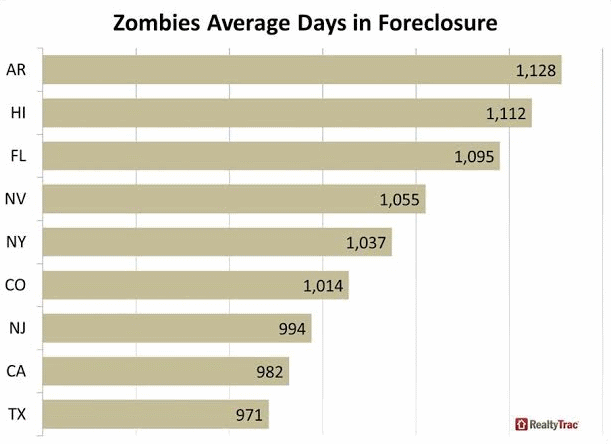After spiking 8 percent in January, foreclosures filings have resumed their downward spiral RealtyTrac said today. Its U.S. Foreclosure Market Report for February notes that filings, including default notices, scheduled auctions, and bank repossessions or completed foreclosures, decreased by 10 percent from January and were 27 percent below levels one year earlier. There were a total of 112,498 filings during the month, the lowest monthly total since December 2006.

Foreclosure starts, which increased 10 percent in January retreated 9 percent in February to a total of 51,842, a 98 month low and 27 percent lower than in February 2013. Foreclosure auctions were scheduled for the first time on 47,715 properties, down 15 percent from the previous month and 21 percent from a year earlier. Bank repossessions (REO) rose less than 1 percent from January to 30,307 but this was 33 percent below the completed foreclosures in February 2013.
There were states that ran counter to each of the national trends but it was not necessarily the same states seeing increases in all categories. Nineteen states had higher numbers of scheduled auctions than a year earlier with Oregon jumping 389 percent and Utah and Connecticut each up over 140 percent. Connecticut was among the 15 states with an increase in REO as well, jumping 162 percent, along with New York (108 percent), Maryland (98 percent), and New Jersey (90 percent). New Jersey also had the largest increase in foreclosure starts with 126 percent more in February 2014 than in February 2013.
States with the highest foreclosure rates in February were Florida, Maryland, and Nevada. But while Florida and Nevada remain on a downward trajectory, Maryland continues to increase. It is now in second place nationally with a filing for one in every 557 housing units after activity increased in February for the 20th consecutive month. On a year-over-year basis, Maryland foreclosure starts increased 15 percent, scheduled foreclosure auctions increased 36 percent, and bank repossessions increased 98 percent.
Florida remains the most active state for foreclosure filings with one in every 372 households affected. However, February marked the 12th consecutive monthly drop in foreclosure starts and the sixth for decreases in bank repossessions. Scheduled auctions decreased 2 percent on an annual basis in February after increasing for 13 straight months.
Nevada's activity also continued to fall, decreasing 16 percent month over month and 49 percent from the previous year. The state still posted the nation's third highest foreclosure rate - one in every 633 housing units with a foreclosure filing.
Other states in the top five for foreclosure activity were New Jersey and Illinois. New Jersey had a filing on one in every 739 housing units, Illinois on one in 811.
Nine of the top 10 metro foreclosure rates in February were posted by cities in Florida, along with Atlantic City, N.J., where overall foreclosure activity increased 254 percent from a year ago.
The RealtyTrac report also included updated information on what it calls zombie foreclosures, properties that were left vacant by the distressed homeowners. The company estimated that 152,033 properties, 21 percent of all properties in foreclosure, had been abandoned as of the first quarter of 2014. This does not include vacant bank-owned properties. The properties had been in the foreclosure process an average of 1,031 days.
The number of zombie foreclosures nationwide did not change substantially from RealtyTrac's report in the third quarter of 2013, but some states saw substantial increases in owner-vacated properties. They increased 27 percent in Michigan, 14 percent in New Jersey, and 21 percent in Nevada. The largest number of such abandoned properties were in Florida, which houses almost 55,000 of them, Illinois, New York, and New Jersey. States with the longest average time in foreclosure for owner-vacated foreclosures included Arkansas (1,128 days), Hawaii (1,112 days), Florida (1,095 days), Nevada (1,055 days), and New York (1,037 days).

"Cold weather and a short month certainly contributed to a seasonal drop in foreclosure activity in February, but the reality is that new activity is no longer the biggest threat to the housing market when it comes to foreclosures," said Daren Blomquist, vice president at RealtyTrac. "The biggest threat from foreclosures going forward is properties that have been lingering in the foreclosure process for years, many of them vacant with neither the distressed homeowner or the foreclosing lender taking responsibility for maintenance and upkeep of the home - or at the very least facilitating a sale to a new homeowner more likely to perform needed upkeep and maintenance.
"One in every five homes in the foreclosure process nationwide have been vacated by the distressed homeowner, but it is closer to one in three foreclosures in some cities," Blomquist added. "These properties drag down home values in the surrounding neighborhood and contribute to a climate of uncertainty and low inventory in local housing markets."







